written by Eric Flowers | photo by Mike Albright
Between the white knuckle rides down Oakridge’s old growth lined trails, trekking around the forested flanks of Mt. Hood, or zipping along Bend’s groomed singletrack, Oregon is a mountain biker’s playground. The state boasts hundreds of miles of dirt trails. Some of these a bit more arduous than others.
“Within a two-hour drive of pretty much anywhere in Oregon, you have a lifetime of riding,” says Adam Craig, a Bend-based professional cross-country and Enduro rider, who relocated to Oregon seven years ago from Colorado because of the abundance of trail riding.
Among the state’s many single-track assets is an abundance of epic rides. Whether you’re looking to circumnavigate an active volcanic caldera or plunge through a temperate rainforest on a five hour point to point, Oregon has something that suits the bill. If you’re looking to go even bigger, Oregon has several multiday excursions that combine amazing riding with campfire camaraderie and well-earned rest under a canopy of stars.
Bachelor to Bend
There are so many possible variations on this route, that it’s hard to nail down just one preferred start and end point, says Lev Stryker, a longtime Bend area rider who, along with his partner, Melanie Fisher, operates the bike touring service Cog Wild. Stryker observes, however, if you really want to bite off an epic ride, wait until early summer when the usually prolific Cascade snowpack is in full retreat and shuttle your bikes to Dutchmen Snowpark across the highway from Mt. Bachelor ski area. From there you can pick your way through a series of interconnecting high-elevation trails that circumscribe Tumalo Mountain before hooking into Mrazek Trail at Happy Valley. Take a deep drink from your Camelbak, down an energy bar and get ready to bear down on fifteen-plus miles of flat out desert single-track screamer as the trail winds through a second-generation pine forest and manazanita brush. The trail ultimately links into the Shevlin Park Trail for a casual ride out along Tumalo Creek.
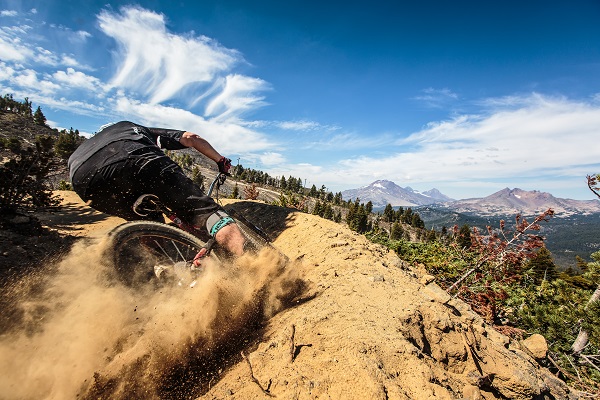
photo by Mike Albright
“You go through all the ecosystems of Bend,” says Stryker. “You’re way up, almost to alpine, and then drop down into deep forest and on into Bend, where it’s almost desert.”
All told, it’s thirty-plus miles of serious riding that requires fitness and logistics. Due to the remote terrain, riders should be ready for contingencies. That entails bringing plenty of food for energy, water to squelch the sometimes scorching summer sun, a first-aid kit and bike tools for the inevitable flat or equipment failure.
Echo Hills Vineyard
If you’re looking to start your season early, you could do worse than this relatively new addition to Oregon’s single-track scene. One of the few mountain biking systems in Eastern Oregon, the Echo Trail system consists of series of concentric loops through zippy terrain that climbs over basalt outcroppings and plunges quickly into desert arroyos. The trail system lies entirely on private land owned by the Echo West Ranch and Vineyard that was made available to local bikers led by former pro rider Shayne Myers, who began constructing trails a little over five years ago, scratching banked single-track turns out of desert dirt.
“It started with an eight-mile loop. Between the stuff that’s mapped and not mapped, there is about twenty-five miles,“ says Myers’ wife, Stephanie. Together, they own Echo Bike and Board shop, which also serves as the intelligence agency for local riding.
While it may not be Oakridge, there’s enough terrain that the trail system plays host to the annual Red2Red mountain bike race that serves as the unofficial kick-off to the Oregon racing season. The race, which begins and ends on Main Street in the aptly named town of Echo (population 699 at last Census count), drew roughly 500 competitors on the first weekend of March 2013. While race week brings the big crowds to the area, the trails ride well year-round, thanks to the dry climate and light traffic. Relatively short, gradual climbs followed by quick descents through sage dotted single-track are hallmarks of the Echo Trail along with signature sections of hand-built bike bridges that keep riders off erosion prone soils. The Meyerses and other trail builders laid out the course directionally with the idea of flattening the climbs while creating short and steep downhills, but have found that many riders prefer to ride them backward, shortening the climbs and extending the descents.
“Most people who are less experienced tend to the like the original way because the climbs are not so steep. But if you want a challenge, you go backward,” Stephanie Meyers says.
Umpqua River Trail
One of Oregon’s bona fide mountain biking gems, this multiday, multisection epic is a buffet-style ride—best enjoyed over multiple visits. For some riders, that means pounding the super challenging Dread and Terror section (yes, it really is called that) on consecutive days, as either an out and back from Lemolo Lake or as shuttle from the While Mule trailhead to the Umpqua Hot Springs, where riders can take a much-deserved soak in the remote pools. If you want the full experience however, consider making camp somewhere near the halfway point of the roughly sixty-mile North Umpqua Trail and make it a multiday trek, says Eric Meglasson, a Bend-based rider whose father Phil Meglasson, pioneered mountain biking in Central Oregon. The younger Meglasson started riding the Umpqua trail a decade and half ago and makes it part of his annual must-ride list. Like the McKenzie River Trail, the Umpqua is one of the premier showcases for Oregon mountain biking, a perfect combination of gritty exertion, heart-pumping downhill and postcard scenery.

photo by Leslie Kehmeier
If you’re looking for a casual day ride or a side excursion on a family camping trip, choose your route carefully. It’s easy to bite off more than you can chew on the Umpqua.
“It’s basically the McKenzie River Trail on steroids,” quips Meglasson. If you do opt for the overnight shuttle ride, Meglasson suggests to skip the last section of the ride unless you’re really feeling masochistic. The Tioga segment is a long slog with an epic climb (roughly 1,000 vertical feet) at Bob Butte.
McKenzie River Trail
Oregon’s iconic single-track route is well loved and its status as one of Oregon’s most iconic rides is deserved. This revelatory ride begins on the crest of McKenzie Pass and winds its way through lava fields, plunging through the temperate rain forest, past waterfalls, old growth fir and cedar trees all the while tracking the blue-green waters of the icy McKenzie River as it rushes toward the Willamette Valley. Beginning at Fish Lake, riders have the option of making an out-and-back ride, with Blue Pool serving as a good turn-around point, or making a bee-line for Belknap hot springs on a twenty-five-plus mile, one-way shuttle route. Whichever way you choose, you can’t go wrong. Whether it’s key-holing through narrow slices of moon rock or flat out ripping along the double-track sections, the McKenzie River Trail is a smorgasbord of knobby tire delights that will test your skills without overwhelming risk.
“I love it because it’s always been challenging, but as I’ve become a better rider, I can do more of the trail to the point where I can now do almost all of it,” says Meredith Bratton, who has been riding the trail annually for several years and uses it as a measuring stick of her own skills.
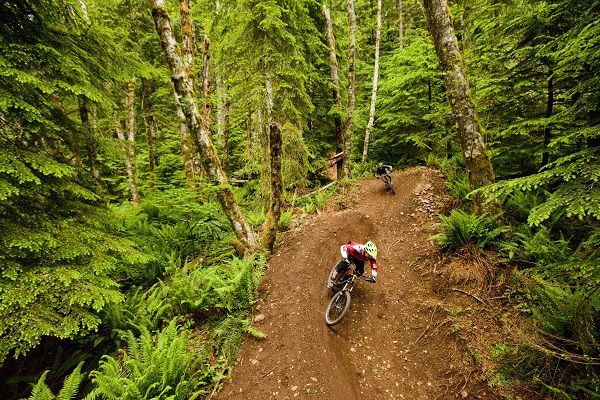
photo by Leslie Kehmeier
While the ride is a gradual descent, it’s a full day of riding with plenty of cross-country elements as the trail meanders away from the river and up adjacent hillsides. In other words, don’t let the elevation drop fool you, this is a full-day ride, not a casual cruise. Like a fine wine, this McKenzie ride should be savored not gulped. Leave the Strava at home and bring along a camera—this place is more about making memories than conquests.
Oakridge Epic ATCA Trail
In a state seemingly spoiled with single-track riches, Oakridge has quietly risen to the top of most dirt enthusiasts’ must-ride lists. The former logging town and its surrounding hillsides are synonymous with epic single-track. Dozens upon dozens of trail miles that are increasingly linked by thigh-busting climbs and scorching downhill descents are the hallmark of this mountain bike mecca.
“A lot of that single-track is some of the best mountain biking in the Northwest—period,” says Derek Bell, who moved to the area seventeen years ago for the riding. He has since watched the area explode in popularity among bikers.
If you’re going to make the pilgrimage, the high-elevation riding typically opens up in May, although this year’s drought conditions had riders out midwinter. While the trail remains in good condition throughout the summer, the best time to experience the area is autumn, says Bell. Cool nights and mild days make for ideal riding conditions. The trails are firm and fast, and fall colors are on full display. If you’re looking to test your endurance and push your skills to the limit, Bell recommends the ATCA Trail. The route is a hybrid of several popular areas anchored by the marquee Alpine Trail, a fifteen-mile high-elevation single-track superstar. The trail connects to the Tire Mountain and Cloverleaf trails before looping back into the Alpine Trail. All told it’s a roughly fifty-mile burner with 8,500 feet of climbing and descending.
“If ever there was an epic and classic mountain bike ride, that would be the one,” says Bell.
With saddle time upwards of six hours, Bell recommends that riders pack plenty of food and water and then pack a little more. Given the distance and relative remote nature of the trail system, spare tires and basic repair tools are mandatory. First-time riders who want up-to-date maps, information on trail conditions and landmarks are encouraged to stop in at Oakridge Bike Shop and Mountain Mercantile for the latest.
Mt. Hood Hut Loop
Bike touring is typically associated with skinny tires and rural highways, but the knobby tire crowd is elbowing its way into the party. In Oregon, that push is largely centered on Mt. Hood, where riders can use a series of single-track trails and backcountry roads to circumnavigate the state’s iconic peak.
It’s possible to put together a DIY route with pre-established camps and supplies, but that’s a lot of logistical wrangling. A better idea is taking advantage of the existing mountain huts that allow riders to rest and refuel without returning to home base.
The half dozen one-room cabins are operated by the North Plains-based Cascade Huts, which keeps the huts stocked with food, water, sleeping supplies and, most importantly, cold beer. The company offers several reasonably-priced self-guided tours, beginning with a three-day ride around the Surveyor’s Ridge area. Riders with more time and ambition can opt to go for the full six-day Mt. Hood circumnavigation.
The ride includes plenty of single-track, but also a fair amount of gravel and jeep road riding to make the necessary trail connections. It also requires a willingness to do some on-the-spot orienteering as the routes aren’t always evident.
“I’d be lying if I said we didn’t get turned around a few times,” says John Prell, a Portland-based real estate broker who tackled the ride with three other riders last August.
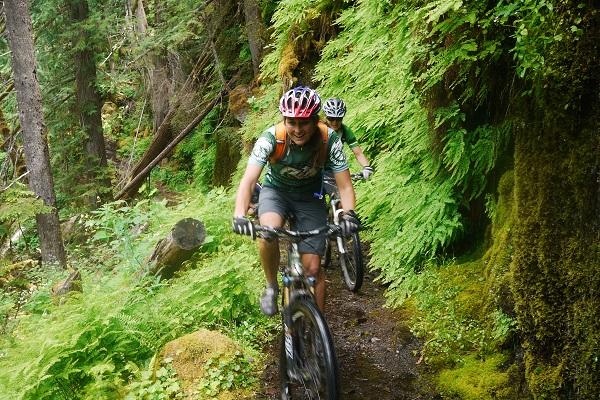
He recommends that every group member have their own set of maps and that the group have at least one backcountry GPS unit. Prell heard about the hut-to-hut route a few years ago and decided to book it in honor of his father’s 70th birthday. The group had such a great experience that Prell is looking to book another trip this year.
The combination of camaraderie, scenery, and the abiding sense of accomplishment at completing such an epic route clinched the Mt. Hood tour’s status as a must-do for Prell.
“I’d recommend it to anybody,” he said.


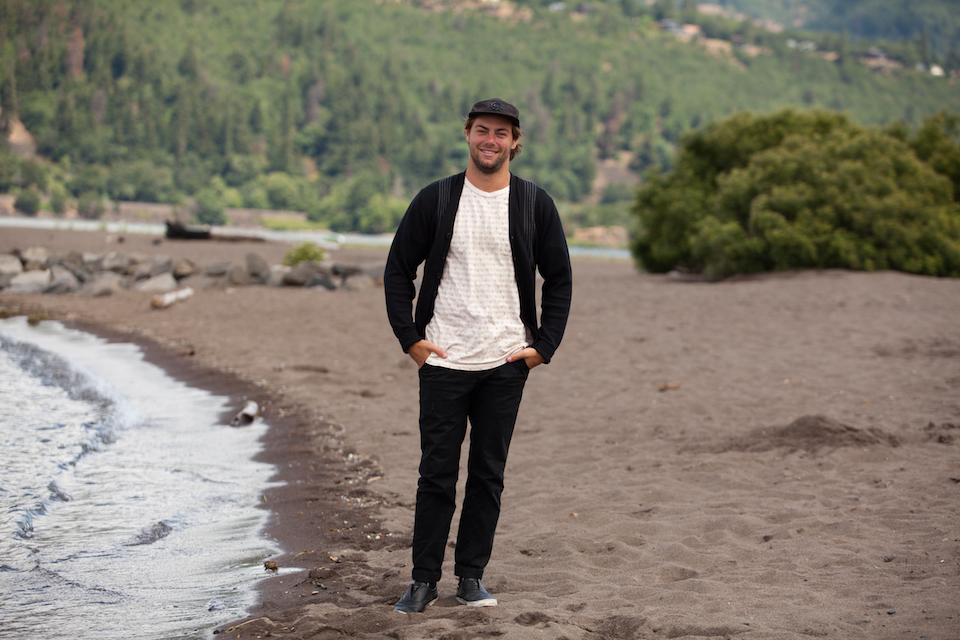
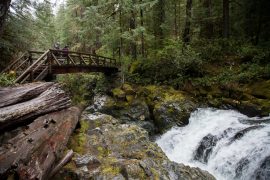
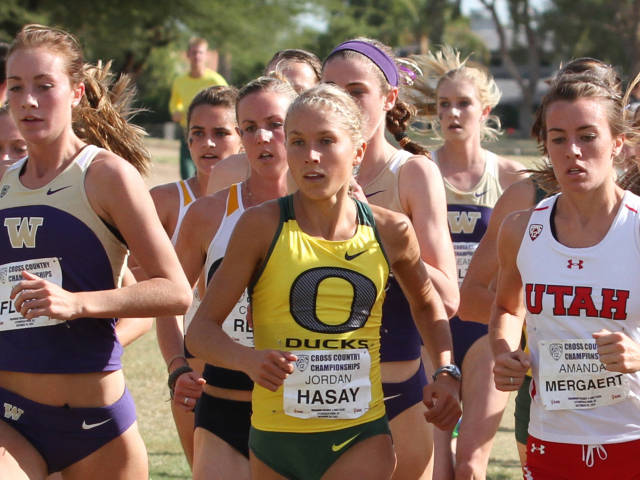




Commenting on the Echo Trail System; being one of the original trail builders out there in 2006 I am glad to see the attention. But the story is incomplete without mentioning the 2 pivotal people responsible for the trails; Lloyd Piercy, owner of the land and vinyard and Brian Cimmiyotti the original trail builder and pioneer of the trails. Brian approched Lloyd in 2004 about trail building and built the orignal loop (A,B,C,D) almost entirely by himself. With Shayne and Stephanie's guidance Red To Red Race has taken off and has become a great early season test for the entire Northwest. The Echo Hills Trailbuilders continue to maintain and improve the trails yearly, making it a destination when the rest of the Northwest is wet or covered in snow.